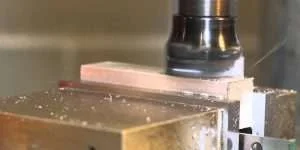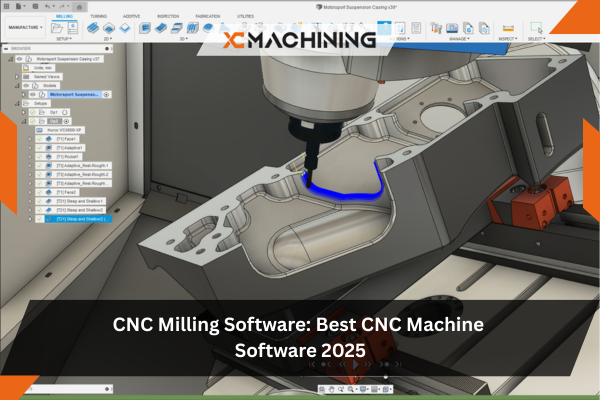Face milling operations is a CNC milling for removing parts of a workpiece, considered by many part manufacturers as the go-to method for flattening or improving the surface finish of a part.
It takes an edge over Face Milling Operations tools such as the fly cutter because of its speed and quality outcome. This article discusses the face milling operation, how it works, its types, and applications.
What is Face Milling?
Face milling is a CNC milling service that uses a face mill cutting tool to flatten or smoothen the surface of a part. The milling operation is unique as the face milling cutter is face down, touching the workpiece with its rotating axis perpendicular to the workpiece. As a result, material removal occurs as the cutting tool rotates on top of the workpiece.
Depending on the milling machine, CNC milling operations can be manual or automatic. Furthermore, this will determine the feed rate and accuracy of the operation.
A manual face machining operation will require the machinist to stop the milling machine and adjust the workpiece. As a result, this alters the feed rate. This does not occur in automatic face machining, which leads to a constant feed rate and improved accuracy.

When to Use Face Milling?
Face milling tools are widely popular in the part manufacturing industries due to their efficiency and quality of outcome. Below are common scenarios where you can use the CNC face milling operations.
Surface Finishing
A face milling tool can be used to improve the surface finish of the workpiece made of metals, plastic, or wood. Hence, it is a common milling tool for large parts with rough spots and other forms of imperfection.
Object Flattening
Face milling operations is also applicable in flattening the surface of a workpiece. While the CNC fixtures is more suitable for already made flat surfaces, it is also suitable for flattening the workpieces with uneven surfaces.
Removing Excess Material
A face milling cutter can also act like a chisel used in the large-scale removal of excessive material on a workpiece. The tool’s typical large cutting diameter allows it to cover a large part of the material, with every rotation removing the excess material.
Types of Face Milling Operations
CNC milling services use different face milling operations to make their desired parts. Each differs based on the tool used with respect to the workpiece.
Conventional Face Milling Operation
From its name, the conventional face milling operation is the most common type. It uses a face milling tool with a cutter with a diameter greater than the workpiece width, i.e., the cutter extends beyond the side of the workpiece.

Partial Face Milling Operation
It is also similar in application to the conventional face milling operations. However, in a partial face milling operation, the face milling cutter’s diameter is slightly less than the workpiece’s width. As a result, the cutter only covers a certain part of the workpiece.
Common CNC prototype machining operations it is suitable for include roughing and finishing cuts.
End Milling Operation
The end milling operation uses a milling cutter with a small diameter compared to the workpiece width. It is suitable for making a quality surface finish, although it is more time-consuming. As a result, this type of face milling operation is more common in making slots in the workpiece.
Profile Milling Operation
Profile face milling operations also involves using a cutter with a diameter smaller relative to the workpiece width. However, it is used in milling the periphery of a flat workpiece to produce a smooth finish.
Pocket Milling Operation
Pocket milling operation also uses a cutting tool with a similar diameter to the profile milling operation and end milling. However, unlike both milling operations, it is applicable in making shallow pockets in a workpiece.
Surface Contouring Milling Operation
The surface contouring face milling operations is also similar to the profile, pocket, and end milling operation based on the diameter of the cutting tool. However, unlike the others, it is applicable for making contours on the workpiece surface.

Face Milling Cutting Tool Types
A face mill cutting is a type of milling cutting tool with a disc shape and cutting edges arranged along its periphery. These cutting edges have unique diameters and can have inserts. Furthermore, they determine the tool’s application and face milling operations. Here are some common face-milling tools types.
Square End Face Mill
These face mills have a square end tip geometry with four cutting edges but no chamfer and radius. They suit milling operations such as plunge cutting, profiling, and slotting.
Ball Nose Face Mill
This face milling operations has a characteristic ball-shaped nose with a radius of half the cutter diameter. Consequently, it is suitable for CNC aluminum machining mating parts of an assembly.
Radius-tipped Face Mill
A radius-tipped face mill has a ground radius on the tip of the cutting edge. As a result, there is a reduced impact on the cutting flutes and better tool life expectancy. They are like the square end face mills. However, they are unsuitable for making a perfectly square-cut profile.
Chamfer Tipped Face Mill
This face milling operations has sided with an angular geometry that ranges from 20° to 45°, allowing it to make chamfered cuts on the workpiece edge. It is suitable for machining operations such as spotting, chamfering, deburring, and beveling.

Inserts
Face milling tool options also differ regarding the inserts on the cutting edges. The inserts come in different shapes, types, and materials suitable for face milling operations. Furthermore, they are replaceable when dull, which helps improve cost-effectiveness and machining. Common inserts include:
- Round Inserts: These inserts suit heavy-duty milling due to their strong cutting edges. As a result, they are the best inserts for tough materials.
- Octagonal Inserts: These face mill inserts provide good stability and chip evacuation. Usually, they are suitable for milling operations with high-feed and low-depth-of-cut.
- Positive Inserts: These face-mills have a positive rake angle, hence their name. They have lower cutting force and provide a better surface finish. As a result, they are common for milling materials such as aluminum and non-ferrous materials.
- Negative Inserts: They are the opposite of positive inserts characterized by a negative rake angle. They have a stronger cutting force, making them suitable for tough materials like steel.
How to Choose Face Mill vs End Mill?
Both face and end mills are essential tools many CNC face milling operations use. Each has a distinct design and function, hence their different applications. However, the end mill application in milling has led to a comparison of face mill vs. end mill.

Function
The face mill is a milling tool better suited for flattening and creating a smooth finish on large and flat surfaces. In contrast, end mills are more versatile machining tools for face and peripheral milling operations such as slotting, contouring, profiling, and drilling.
Metal Removal
Both end mills and face mills can be used for metal removal. However, face mills have a significantly higher metal removal rate. As a result, milling is the better CNC face milling operations for roughing and removing material on a large scale from a workpiece.
Precision and Details
Unlike end mills, face mills are less precise and are less suitable for intricate details due to their large cutting diameter. In contrast, end mills can make precise cuts on a workpiece. Hence, they are suitable for creating slots, chamfers, and intricate details
Tool Cost
A face mill is a cost-effective option when working with large workpieces. On the other hand, end milling incurs a higher cost, especially when working with intricate designs
Cutting Depth
Face mills are more suitable for making shallow cuts on a workpiece. In contrast, the design of an end mill makes it more suitable for deep or precise cuts. As a result, end mills are milling tools used in deep milling operations such as pocketing and deep slotting.

Tips for A Better Face Milling Operation
A successful face milling operations comes from understanding several factors related to the cutting tool, choice of materials, and milling machine at large. Below are some tips to help you improve when using milling:
Choose the Right Cutting Tool
The success of a face milling operations depends on the choice of the cutting tool and inserts. According to Petrilin, technical manager for ISCAR Tools, the cutting tool’s edge determines its application. For example, a face mill with a 45° angle is suitable for open-plane surfaces, while a 90° mill is better for faces bounded by a shoulder. Also, Petrilin suggests being able to predict the insert tool life as it ensures stable machining result and reduces the production costs.
Recommended Spindle Rotating Speed
The recommended spindle rotating speed reduces tool wearing and extends the tool’s life expectancy. Furthermore, it increases chip evacuation and the quality of the milled product.
Cutting Tool Position
The face-cutting tool should be positioned off-center from the workpiece. As a result, this leads to the creation of thin chips, allowing you to achieve a cleaner cut and finer surface finish.
Secure the Workpiece
Securing the workpiece with the right fixture and clamps will remove vibration and unintended movements that can mar the quality of the finished parts after the milling operation. Therefore, this will ensure the maintenance of a smooth surface finish and the precision of milled parts.
Avoid Stressing Workpiece
Entering and exiting the workpiece frequently during face milling operations can stress the tool’s cutting edge. Consequently, this can affect the process’s accuracy and the milled part’s quality. Also, avoid milling over holes or slots, which can affect the cutting tool.
Differences Between Face Milling and Peripheral Milling
Face milling and peripheral milling operations both use a rotating CNC cutting vs laser cutting. However, the two CNC milling operations are different, as shown in this section:

Position of Cutting the Workpiece
The major face milling vs. peripheral milling distinction is the position of cutting the workpiece. In a milling operation, the milling cutter faces the workpiece perpendicularly. This means the top of the cutting tool removes the top of the workpiece. In contrast, the milling cutter in a peripheral milling operation is parallel to the workpiece. This means that the sides of the cutter grind away at the top of the workpiece.
Large Material Removal Rate
Peripheral milling cutters use the side to remove part of the workpiece, which allows the removal of a large amount of the workpiece. On the other hand, the face milling operation is suitable for minimal removal of materials compared to peripheral milling.
Design of the Milling Cutter
In a face milling tool, the cutters are on the periphery and face of the milling cutter. In contrast, the cutters are only on the periphery of the peripheral milling tool.
Compatible Spindle Machine
Face milling is compatible with horizontal and vertical spindle machines, while peripheral milling can only occur on horizontal spindle machines.
Get Started Custom Milled Parts at XC Machining
A CNC milling operation is a delicate business only a professional should undertake. At XC Machining, we focus on part quality, guaranteeing the production of custom-milled parts crafted with precision and characterized by enhanced performance quality.
Experience how we differ from others by trusting a custom CNC face milling operations for your project. Contact us today for custom-milled parts, and let us turn your idea into reality.
Conclusion
Face milling is a CNC machining operation that uses a cutting tool to flatten or smoothen the surface of a workpiece. It has a high material removal rate, hence its wide popularity. This article discusses how the face milling operations tool works, the different types, and its unique applications.
FAQs
What is a side and face milling operation?
A side milling operation is a type of peripheral milling that uses a cutting tool with a lesser diameter than the workpiece width. It is applicable for removing materials at the side of a workpiece, creating a parallel cut on vertical slots. In contrast, a conventional face milling operation uses a face milling tool with a cutter with a diameter greater than the workpiece width, i.e., the cutter extends beyond the side of the workpiece. It is suitable for roughing the workpiece.
What is the application of face milling?
Face milling is widely applied in the part manufacturing industry for flattening, squaring, and improving the surface finishing of a workpiece.
How to select the best cutting inserts for face milling tools?
There are several factors to consider when selecting the right cutting insert for a face milling tool. These include the insert’s geometry, the machine cutting speed and feed rate, insert material shape, compatibility, and chip control.





